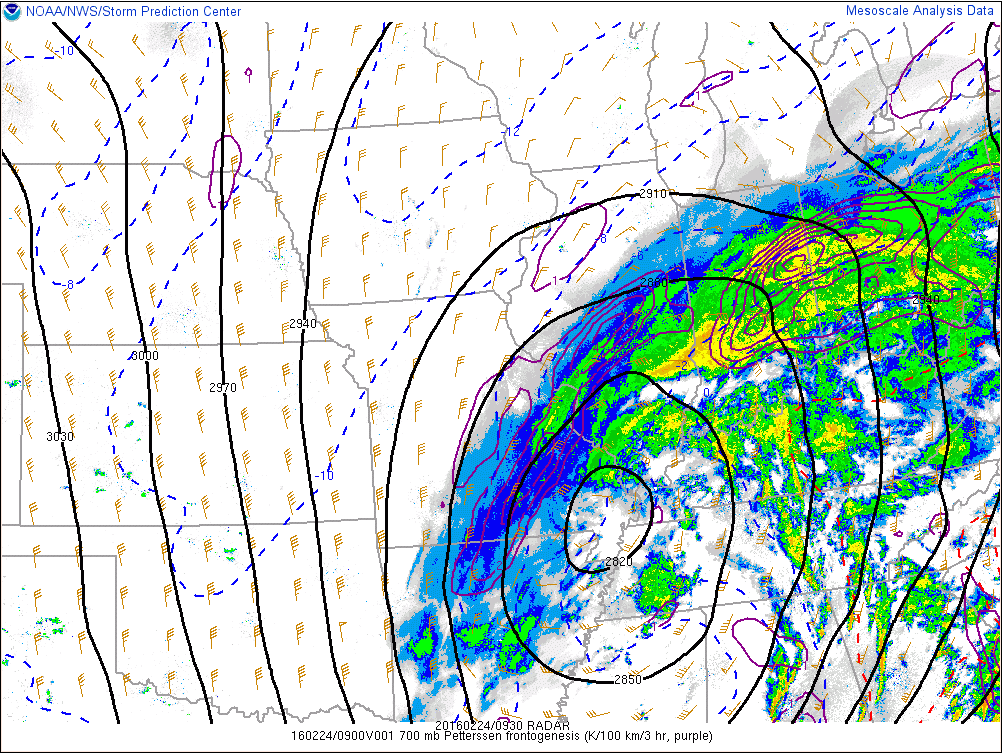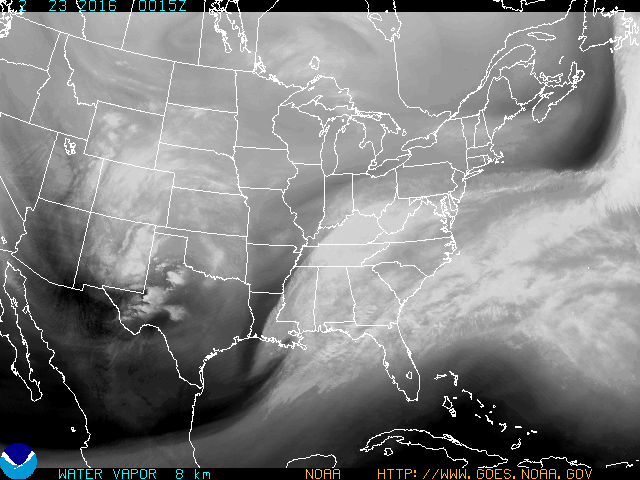Northern Indiana
Weather Forecast Office
| February 24th - 25th 2016 Snowstorm |
A vigorous disturbance embedded with the subtropical branch of the jet stream lifted out of Texas early on the 23rd and phased with a northern stream disturbance crossing the northern plains. This system intensified rapidly, eventually closing off across southern Indiana on the 24th. A pronounced deep moisture surge out of the Gulf of America combined with just enough cold air in place at the surface, resulted in a signficant winter storm for portions of the Great Lakes. While heavy snow fell over eastern Illinois northeastward across northern Indiana and much of lower Michgan, enough warm air wrapped into the intensifying cyclone to change the precipitation over to rain across east central Indiana and western Ohio.
As the system lifted out into southeast Canada the night of the 24th, residual moisture combined with renewed cold air crossing Lake Michigan resulted in considerable lake enhanced snowfall over northern Indiana and southwest Michigan. Most locations here received between 6" and 12" of snow with pockets of heavier snow noted over northern La Porte, Porter and Lake counties with 17.8" measured at the La Porte COOP station.
Below is a map of general snowfall reports across the area.

Click here for Snowfall Reports
LOCATION STORM TOTAL
SNOWFALL
/INCHES/
1 WNW La Porte 17.8
2 N Laporte 17.0
(N9ROM)Trail Creek 4.5 ESE 15.0
Lakes Of The Four Seasons 1.5 NNE 15.0
Trail Creek 4.5 ESE 14.0
Portage 2.8 E 14.0
Valparaiso 5.7 WSW 13.0
Valparaiso 1.8 NW 12.8
1 WSW Nappanee 12.5
Valparaiso 2.0 WSW 12.0
Valparaiso 0.6 SE 11.5
1 NW Tippecanoe Lake 11.5
Leesburg 6.7 ESE 11.4
Litchfield 0.3 ENE 11.4
South Bend 4.5 SE 11.0
Jackson 3.2 W 11.0
South Bend Airport 10.9
Plymouth 2.5 WSW 10.8
North Webster 2.3 N 10.6
Rensselaer 1.9 SSW 10.5
Hebron 3.7 NE 10.5
Medaryville 10.4
1 WSW Plymouth 10.2
De Motte 0.8 NNW 10.0
De Motte 1.2 SSW 10.0
Buchanan 1.3 WNW 10.0
Plymouth 5.4 W 10.0
3 ENE Buchanan 10.0
Union City 10.0
Moscow 10.0
Dorr 0.4 E 9.8
Ann Arbor 2.1 WNW 9.8
Syracuse 0.9 SW 9.5
Hanover 3.8 W 9.5
Granger 2.9 W 9.2
Goshen 3 W 9.1
Goshen 3.0 WSW 9.1
Hopkins 2.0 N 9.1
Buchanan 1.4 ESE 9.1
Dowagiaac 5.3 NNW 9.1
1 NW Kingsbury 9.0
(KA9WNQ)La Porte 1.7 SW 9.0
La Porte 1.6 SW 9.0
Kingsbury 0.3 WNW 9.0
Niles 2.7 W 9.0
Walkerton 5.7 ENE 8.9
Rives Junction 4.0 NW 8.8
Wanatah 4.4 ESE 8.6
Golden Lake 1 SW 8.5
Warsaw 2.9 SE 8.5
South Bend 4.6 SE 8.5
Hudson 4.1 NNW 8.5
New Paris 8.5
1 WSW Indiana Beach 8.5
Wakarusa 0.3 WSW 8.3
Medaryville 5 N 8.2
Stevensville 1.7 SSE 8.2
Remington 0.3 N 8.1
Rochester 8.0
Millersburg 0.5 SW 8.0
Wakarusa 2.4 NNE 8.0
Portage 0.9 ESE 8.0
Chesterton 4.2 E 8.0
Three Oaks 8.0
Metz 8.0
North Judson 0.7 SSW 7.5
Granger 1.8 ENE 7.5
Angola 4.1 N 7.5
(KE9ML)North Judson 0.7 SSW 7.5
Allendale 1.3 SSW 7.5
Sturgis 7.5
Warsaw 1.1 NNW 7.4
North Judson 3 S 7.3
Elkhart 4.8 SW 7.3
Francesville 7.2
North Judson 3.9 SW 7.0
(W9OPR)Wheatfield 1.4 ENE 7.0
(WA9RON)La Porte 1.3 SSW 7.0
Hamilton 1.7 E 7.0
(KB9GPW)North Judson 3.9 SW 7.0
Burnettsville 9.9 NNW 7.0
Paw Paw 3.6 NNE 7.0
Fremont 3 SW 7.0
Albion 3.7 S 6.8
Warsaw 1.4 N 6.7
Ann Arbor 3.1 SE 6.7
Goshen 1.2 SW 6.5
Monticello 5.5 NNW 6.5
Chelsea 2.4 WNW 6.5
De Motte 4.1 SW 6.4
Kendalville 6.4
Mishawaka 3.9 ENE 6.3
North Judson 5.7 ESE 6.0
Lafayette 2.2 NE 6.0
Constantine 1.9 E 6.0
Columbia City 8.4 N 5.8
Winona Lake 1.1 E 5.7
Three Rivers 1 S 5.5
Lafayette 2.2 S 5.2
(N9VZS)Kokomo 2.5 S 5.0
Claypool 1.2 E 5.0
Monticello 1.0 NNE 5.0
Perrysburg 1.6 WSW 5.0
West Lafayette 5.1 WSW 4.5
Hanna 1.1 E 4.4
Adrian 5.2 NE 4.2
Waterville 2.4 NNE 4.0
Young America 4.0
Toledo 2.2 WSW 3.7
Auburn 0.8 NE 3.6
Denver 1.3 NE 3.5
Holland 4.3 NNW 3.5
North Manchester WWTP 3.0
Napoleon 4.5 NNW 2.6
(WA9TTB)Galveston 1.0 ESE 2.5
Atlanta 4.4 W 2.5
(K9WKK)Tipton 1.3 NW 2.5
Fremont 2.2 ENE 2.5
Bowling Green 2.7 NW 2.5
Galveston 1.0 ESE 2.5
McClure 3.4 SSE 2.4
Newport 3.1 SE 2.3
Port Clinton 2.5 W 2.3
Fort Wayne 4.1 NE 2.1
Frankfort 4.9 NNE 2.1
Defiance 0.9 E 2.1
Anderson 2.2 NNE 2.0
(KC9ZPE) Modoc 0.1 NNW 2.0
Napoleon 0.6 WSW 2.0
(KC9QCJ) Shamrock Lakes 3.0 NNW 1.9
Hartford City 4.8 NW 1.8
Anderson 2.0 S 1.8
Portland 2.3 S 1.7
Bluffton 0.9 SE 1.7
Bradford 2.3 NW 1.6
Woodburn 2.8 WSW 1.5
Fort Wayne 2.6 NE 1.5
(KA9VIS) Hartford City 0.7 N 1.5
Hartford City 0.2 NNW (WB9HLA) 1.5
Kokomo 7.2 WNW 1.5
Kokomo 4.3 SW 1.5
Arlington 0.4 SW 1.5
Raymond 3.5 NW 1.5
Fort Wayne Airport 1.4
Lima 2.7 NE 1.4
Fort Wayne 7.0 NE 1.2
Huntington 0.3 W 1.1
Pitsburg 1.4 ENE 1.1
(WB9USA) Yorktown 1.1 NNE 1.0
(KC9DHF)Kokomo 4.4 E 1.0
(K9UZZ) Saratoga 3.4 WNW 1.0
(KC9FXU) Winchester 2.2 WSW 1.0
Put-In-Bay 1.1 SSW 1.0
Fort Loramie 0.8 NNW 0.9
Potsdam 2.6 WSW 0.8
Houston 1.3 NNE 0.8
Galloway 3.1 N 0.7
Harrisburg 3.7 WNW 0.6
Muncie 1.2 SE 0.5
(KC9TLC) Muncie 0.6 W 0.5
(KC9IYD)Kokomo 4.0 WNW 0.5
(K9EKP) Parker City 0.3 NE 0.5
Wabash 0.3 NNW 0.5
Versailles 1.6 WSW 0.5
Marion 4.2 SSE 0.5
Marion 5.6 NE 0.3
(KC9LQY) Portland 5.4 SW 0.3
Pennville 0.2 NW 0.2
(KB9ZZG) Albany 2.9 E 0.2
(NQ8E) Muncie 0.6 NE 0.0
(KC9ZUA) Muncie 2.5 W 0.0
OBSERVATIONS ARE COLLECTED FROM A VARIETY OF SOURCES WITH VARYING
EQUIPMENT AND EXPOSURE. NOT ALL DATA LISTED ARE CONSIDERED OFFICIAL.
Click here for Peak Wind Gusts
NOUS43 KIWX 252016 PNSIWX INZ003>009-012>018-020-022>027-032>034-MIZ077>081-OHZ001-002-004-005-015- 016-024-025-260816- PUBLIC INFORMATION STATEMENT NATIONAL WEATHER SERVICE NORTHERN INDIANA 316 PM EST THU FEB 25 2016 ...MAXIMUM WIND REPORTS PAST 36 HOURS... LOCATION SPEED TIME/DATE LAT/LON ...MARINE REPORTING STATIONS... 2 WNW MICHIGAN CITY 58 MPH 0506 PM 02/24 41.73N/86.91W ...INDIANA... ...DE KALB COUNTY... 3 E SAINT JOHNS 35 MPH 1255 PM 02/25 41.31N/85.06W ...ELKHART COUNTY... GOSHEN MUNICIPAL AIRPORT 38 MPH 0151 PM 02/25 41.53N/85.79W ELKHART MUNICIPAL AIRPORT 37 MPH 0150 PM 02/25 41.72N/86.00W ...HUNTINGTON COUNTY... 3 SSW HUNTINGTON 35 MPH 0229 PM 02/25 40.83N/85.53W ...LA PORTE COUNTY... LA PORTE 44 MPH 0315 PM 02/24 41.57N/86.73W ...MIAMI COUNTY... 1 SSW GRISSOM AFB 37 MPH 1144 PM 02/24 40.65N/86.15W ...ST. JOSEPH COUNTY... SOUTH BEND INTERNATIONAL AIR 40 MPH 0723 AM 02/25 41.71N/86.32W ...STARKE COUNTY... 2 ESE BREMS 39 MPH 0535 PM 02/24 41.33N/86.66W ...WHITE COUNTY... WHITE CNTY AP 35 MPH 0115 AM 02/25 40.71N/86.77W ...MICHIGAN... ...ST. JOSEPH COUNTY... STURGIS 36 MPH 0815 PM 02/24 41.81N/85.44W ...BERRIEN COUNTY... SAINT JOSEPH 43 MPH 0600 PM 02/24 42.10N/86.49W COLOMA 40 MPH 1200 AM 02/25 42.20N/86.31W SOUTHWEST MICHIGAN REGIONAL 37 MPH 0546 PM 02/24 42.13N/86.43W COLOMA 40 MPH 1200 AM 02/25 42.20N/86.31W ...CASS COUNTY... 1 WSW DIAMOND LAKE 38 MPH 1100 AM 02/25 41.90N/86.00W OBSERVATIONS ARE COLLECTED FROM A VARIETY OF SOURCES WITH VARYING EQUIPMENT AND EXPOSURE. NOT ALL DATA LISTED ARE CONSIDERED OFFICIAL. $$ NWS NORTHERN INDIANA IRIS SYSTEM
| Surface Analysis Loop from 7 pm Tuesday through 1 am Thursday |
 |
| This loop shows the track of the surface cyclone from northeast LA on the evening of Feb 23th to western NY by early morning Thursday. |
| Radar Loop from 330 am Wednesday through 927 am Thursday |
 |
| This loop shows how persistent the strong radar echoes (dark blues - moderate precipitation, purples - heavy precipitation) were across northwest and north central Indiana for a several hour period on Wednesday, from early morning well into the evening. Additional lake enhancement developed Wednesday night and continue through mid morning Thursday dropping several inches of additional snow. |
 |
 |
 |
 |
 |
 |
 |
 |
Updated 2/27/2016 5:30 AM EST
Hazards
Heat Related
Watch/Warning
Outlook
Storm Prediction Center
Storm Reports
Submit a Report
Outdoor Event Watcher
EM Briefing
Current Conditions
Hourly Weather
Surface Observations
Regional Temps/Precip
Precip Reports
Satellite
Climate
CoCoRaHS
FWA Daily
SBN Daily
FWA Monthly
SBN Monthly
Cliplot
Spring Frost Climatology
Fall Frost Climatology
Severe Climatology
Tornado Climatology
Local Information
Public Information Statement
Probabilistic Snowfall
Storm Data
Skywarn
COOP
Our Office
WSR-88D
Headline Criteria
NOAA Weather Radio
Weather History
Social Media Feeds
Weather Events Page
US Dept of Commerce
National Oceanic and Atmospheric Administration
National Weather Service
Northern Indiana
7506 E 850 N
Syracuse, IN 46567
574-834-1104
Comments? Questions? Please Contact Us.



